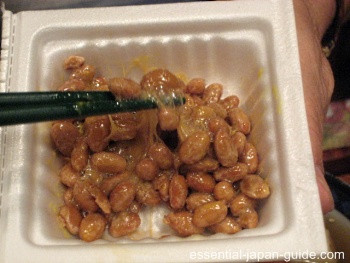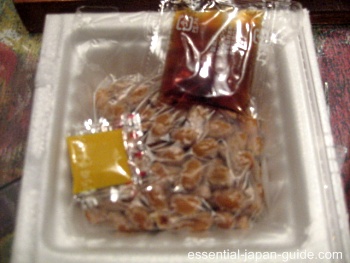Japanese Natto and Nattokinase: Japan’s Stinky Superfood!
Japanese natto is the infamously pungent fermented soy beans that Japanese love to ask visitors if they like, and which resident gaijin must try at least once in order to prove their mettle as connoisseurs of all things Japan. Sticky, stinky, stringy, and yet oh so healthy, there is no middle ground. You’ll either love natto or hate natto, but you can natto ignore it!

![]()
What is Natto?
Natto is a sticky, pungent fermented soybean that according to some historians has been part of the Japanese diet for over 1,000 years. Usually sold in store-bought packs, and served most commonly over rice, natto is an important daily food staple and source of nutrition for a significant portion of the Japanese population. The rest of the population can’t stand the sight or smell of it.
Health Benefits of Natto
Natto is rich in protein, and among other benefits is thought to be effective in the prevention of heart attacks, strokes, cancer, osteoporosis, obesity, and intestinal disease.
![]()
Nattokinase
Nattokinase is an enzyme extracted and purified from natto, which is available in a tasteless, odorless capsule form. Nattokinase is regarded as effective for reducing blood pressure and clots, and as a blood thinner. So if you’re looking for all of the health benefits of natto but without the foul smell, nattokinase is a fantastic alternative!
![]()
Unique Characteristics of Japanese Natto
Although the little beans look harmless enough at first glance, natto has several unique characteristics that quickly separate the true natto lovers from the natto loathers.
 The visual appearance of natto:
The visual appearance of natto:
First and foremost, natto doesn’t look all that appetizing. In fact, to some, the fermented beans look a lot like a pile of insect eggs that are about to hatch.
 The smell of natto:
The smell of natto:
Open up a pack of natto, and you cannot avoid noticing the intensely pungent smell that rushes up and hits you like a slap in the face. Some describe it as akin to rotten Limburger cheese; to others the smell is simply indescribable. And yet there are many that happily eat it day after day with nary a crinkle of the nose.
 The stickiness of natto:
The stickiness of natto:
If you can get past the smell of natto, next you have to deal with the stickiness of the beans. The Japanese have a fun word, “neba-neba,” that perfectly describes the sticky and gooey texture of natto.
 The stringiness of natto:
The stringiness of natto:
Finally, once you’ve gotten past the smell and sticky qualities of natto, you’ll dig your chopsticks in and pull up a bite, only to find your mouthful still attached to the bowl by about a thousand gooey, spider-web-like strings. This stringy quality of natto is also off-putting to many would be eaters.
![]()
How to Eat Japanese Natto
Open up a pack and you’ll find the natto along with little packs of soy sauce and mustard. Add the soy sauce and mustard, and stir briskly. Top with chopped green onions, if desired. If you haven’t run for the Porcelain Goddess yet, serve on top of rice or eat it straight from the original container.

If the intense odor and texture of natto is too much to deal with but you’re not quite ready to give up on it, try eating it in combination with other foods. Natto can also be added to miso soup or pasta, stir fried (which reduces the pungency somewhat), or used as a filling for rolled sushi or onigiri. Sometimes eating these forms of “training natto” will build up your tolerance so that eventually you can eat it straight.
![]()
Where to Buy Natto
In Japan, natto is most commonly sold in single-serving packs sold in Japanese grocery stores and convenience stores. Some convenience stores and sushi shops sell natto-filled sushi rolls and onigiri. If you’re living abroad, your best bet for finding natto will probably be a Japanese or Asian grocery store.

If you can make it past the appearance, the smell, the stickiness, and the stringiness and still enjoy it, in Japanese natto you’ll have a healthy source of food for life, as well as bragging rights as a one of the few and proud gaijin that can actually answer yes to the inevitable question from your Japanese friends and hosts: “Do you like natto?”
![]()
